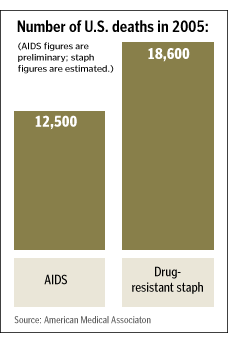New York Times
By RONI CARYN RABIN
Published: January 20, 2009
Children are picking up more stubborn staph infections that don’t respond to common antibiotics, and the proportion of ear, nose and throat infections resistant to standard drug treatment increased dramatically over a six-year period, a new study has found.
Methicillin-resistant Staphylococcus aureus infections, known as MRSA, accounted for 28.1 percent of children’s head and neck staph infections in 2006, up from just 11.8 percent in 2001, according to researchers at Emory University in Atlanta. It once was rare for an ear, nose and throat doctor to see MRSA infections, noted Dr. Steven E. Sobol, the paper’s senior author and director of pediatric otolaryngology at Emory University School of Medicine.. “That was the impetus for the study,” he said.
The report was published in this week’s issue of Archives of Otolaryngology - Head and Neck Surgery.
“Over the past four or five years, we’ve seen an increased prevalence of these infections that used to be caused by other organisms that are now being caused by MRSA,” said Dr. Sobol. The researchers excluded from their analysis skin infections not caused by staph.
Though the study captured information from only a limited number of laboratories, the report’s authors said the overall trend is clear, concluding that there is “an alarming nationwide increase” in the prevalence of MRSA infections in children. The change parallels an increase in so-called community-acquired cases of MRSA among relatively healthy people who aren’t hospitalized or infirm.
The scientists analyzed 21,009 head and neck staph infections occurring among children from January 2001 to December 2006. The data came from a national electronic microbiology database that collects strain-specific drug resistance test results from labs affiliated with 300 hospitals around the country. The average age of the patients was 6.7 years old.
The proportion of drug resistant head and neck staph infections increased dramatically over the six-year period, the researchers found. Overall, 21.6 percent, or 4,534 samples, were methicillin-resistant, the greatest proportion of them involving the ear, nose and sinus and pharynx.
Only 11.8 percent of childhood head infections were resistant in 2001, but the figure jumped to 12.5 percent in 2002, 18.1 percent in 2003, and 27.2 percent in 2004.
The rate fell to 25.5 percent in 2005 and rose again to 28.1 percent in 2006, the researchers reported.
Almost 60 percent of the head and neck infections occurred among children who had not been in medical settings beforehand and were seeing doctors as outpatients, the researchers said, suggesting that children were exposed to resistant bacteria in the community.
Op-Ed Columnist
Sunday, March 22, 2009
Subscribe to:
Posts (Atom)








